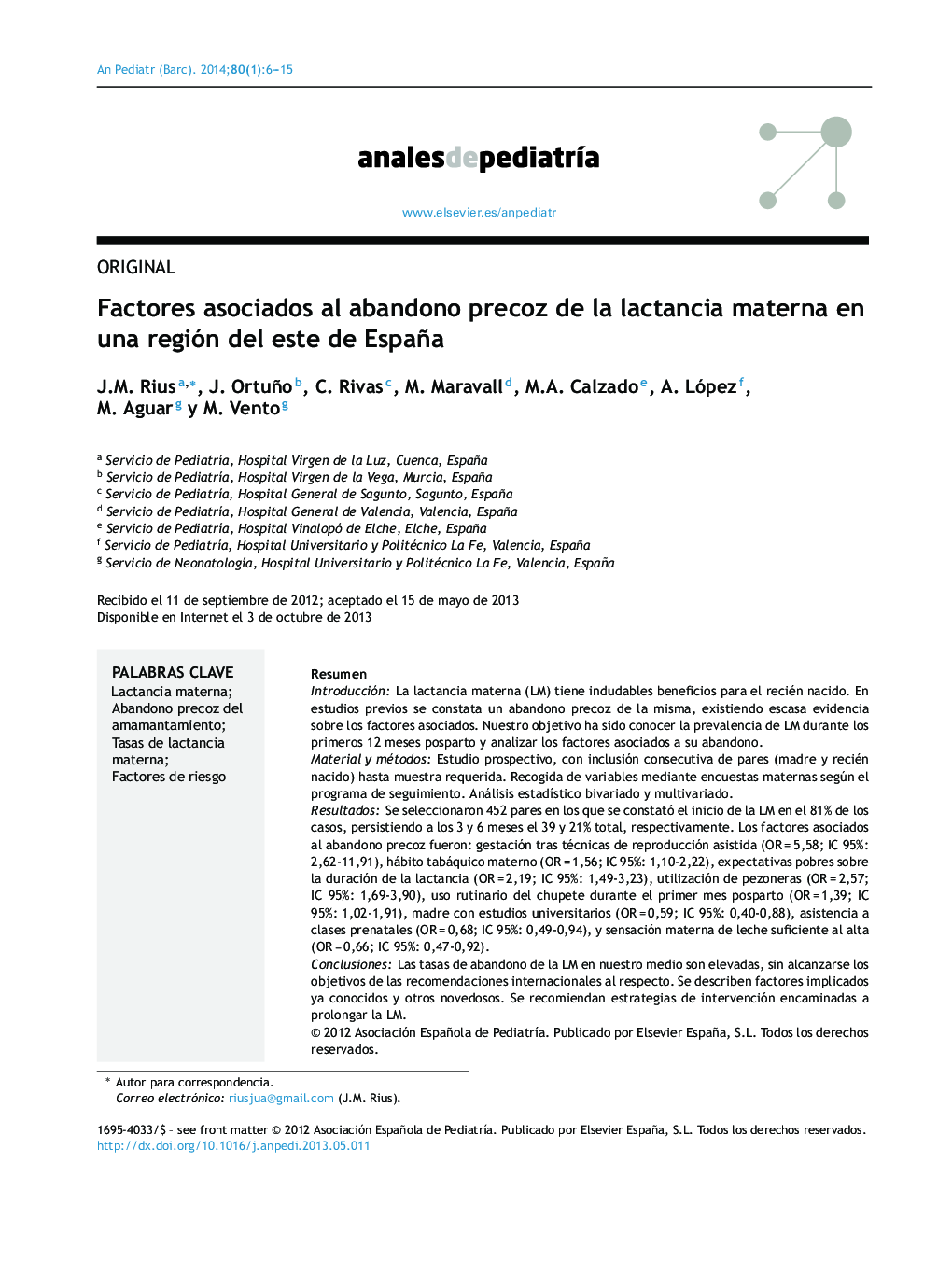| Article ID | Journal | Published Year | Pages | File Type |
|---|---|---|---|---|
| 4141585 | Anales de Pediatría | 2014 | 10 Pages |
ResumenIntroducciónLa lactancia materna (LM) tiene indudables beneficios para el recién nacido. En estudios previos se constata un abandono precoz de la misma, existiendo escasa evidencia sobre los factores asociados. Nuestro objetivo ha sido conocer la prevalencia de LM durante los primeros 12 meses posparto y analizar los factores asociados a su abandono.Material y métodosEstudio prospectivo, con inclusión consecutiva de pares (madre y recién nacido) hasta muestra requerida. Recogida de variables mediante encuestas maternas según el programa de seguimiento. Análisis estadístico bivariado y multivariado.ResultadosSe seleccionaron 452 pares en los que se constató el inicio de la LM en el 81% de los casos, persistiendo a los 3 y 6 meses el 39 y 21% total, respectivamente. Los factores asociados al abandono precoz fueron: gestación tras técnicas de reproducción asistida (OR = 5,58; IC 95%: 2,62-11,91), hábito tabáquico materno (OR = 1,56; IC 95%: 1,10-2,22), expectativas pobres sobre la duración de la lactancia (OR = 2,19; IC 95%: 1,49-3,23), utilización de pezoneras (OR = 2,57; IC 95%: 1,69-3,90), uso rutinario del chupete durante el primer mes posparto (OR = 1,39; IC 95%: 1,02-1,91), madre con estudios universitarios (OR = 0,59; IC 95%: 0,40-0,88), asistencia a clases prenatales (OR = 0,68; IC 95%: 0,49-0,94), y sensación materna de leche suficiente al alta (OR = 0,66; IC 95%: 0,47-0,92).ConclusionesLas tasas de abandono de la LM en nuestro medio son elevadas, sin alcanzarse los objetivos de las recomendaciones internacionales al respecto. Se describen factores implicados ya conocidos y otros novedosos. Se recomiendan estrategias de intervención encaminadas a prolongar la LM.
IntroductionBreastfeeding has undoubtedly great benefits. Previous studies have foundan early dropout. Only a few studies have investigated related factors. Our aim was to find out on-going breastfeeding rates along the first 12 months after birth and analyse factors associated with early weaning.Material and methodsThis is a prospective study including consecutive pairs (mother and newborn) till completion of the required sample. Variables were collected performing a structured program of surveys to the mothers. Bivariate and multivariate analysis of the data was performed.ResultsA total of 452 pairs were recruited. It was found that 81% of them started breastfeeding, with a prevalence of breastfeeding of 39% and 21% at 3 and 6 months after birth, respectively. Factors associated with early discontinuation of breastfeeding were: pregnancy induced by assisted reproduction methods (OR = 5.58; 95% CI: 2.62-11.91), maternal smoking (OR = 1.56; 95% CI: 1.10-2.22), poor maternal expectations about the duration of breastfeeding (OR = 2.19; 95% CI: 1.49-3.23), use of nipple shields for breastfeeding (OR = 2.57; 95% CI: 1.69-3.90), pacifier use on a regular basis during the first month after delivery (OR = 1.39; 95% CI: 1.02-1.91), maternal university educational level (OR = 0,59; 95% CI: 0,40-0,88), attending birth preparation programs during pregnancy (OR = 0,68; 95% CI: 0,49-0,94), and believing having enough milk output at the time of discharge (OR = 0,66; 95% CI: 0,47-0,92).ConclusionsInternational recommendations about duration of breastfeeding are not achieved in our country because of high rates of early weaning. We describe the known factors involved and other novel factors. The implementation of interventions to increase breastfeeding rates and to prevent early weaning are strongly recommended.
